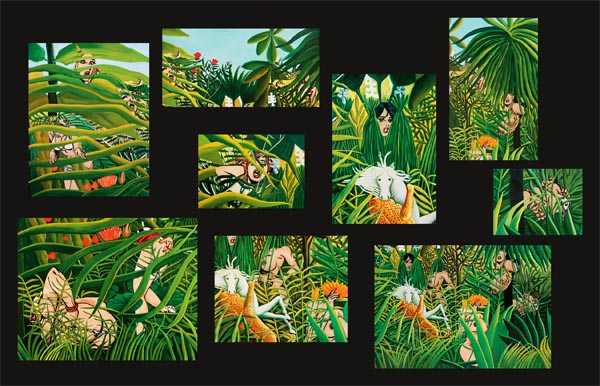![[Francis Naumann]](/4logo.gif)
![[Francis Naumann]](/4logo.gif)

(November 11 – December 23, 2009)
“Pamela Joseph: Wunderlust,” is the artist’s first show at Francis M. Naumann Fine Art, and her first major one-person showing in a New York gallery.

“Wunderlust” is a term of the artist’s invention, a combination of the German wanderlust—meaning a desire to wander or travel—with the English word “wonder,” implying admiration or awe, particularly for something exceptionally beautiful. The two words form an ideal summary of her paintings, which take viewers on an excursion through familiar images that are infused with unexpected and sometime comical diversions, inspiring wonder at the sheer virtuosity of the transformation. At times these changes can be somewhat disconcerting, as when images excised from comic books appear in unexpected places. This technique is used throughout the exhibition, but is perhaps most powerful in her series Rousseau Cinématique, nine paintings based on Henri Rousseau’s The Horse Being Attacked by a Jaguar (1910). Here, Joseph begins the process by working with a postcard reproduction of the Rousseau painting, integrating—by means of collage—images culled from erotic comic books, so that throughout the scene, women’s heads and body parts appear and seem to disappear within the dense jungle foliage. Since the process began with a postcard, Joseph then reproduces the nine resultant paintings in a postcard pack, which not only enhances the cinematic effect, but which also amusingly restores the imagery to its original source.
A similar process is employed in transforming other well-known visual images, ranging from Pablo Picasso’s Les Demoiselles d’Avignon to Hokusai’s The Great Wave. The artists Joseph has appropriated represent a roster of the greatest painters of the 19th and 20th century : Francis Bacon, Joan Brown, Paul Cézanne, Gustave Courbet, Salvador Dalí, Raoul Dufy, Marcel Duchamp, Eric Fischl, Arshile Gorky, Philip Guston, Anton Henning, Ando Hiroshige, Edward Hopper, Roy Lichtenstein, Fra Filippo Lippi, Réné Magritte, Henri Matisse, Michelangelo, Alice Neel, Georgia O’Keeffe, Eduardo Paolozzi, Guido Reni and Diego Rodriguez De Silva y Velázquez.
The show ends with the last painting made by the artist, American Nudism, which—like the other works in the exhibition—began with a postcard, but in this case, it does not reproduce a work of art, but rather the image of three nude, middle-aged figures standing on an outdoor deck. Printed on the verso of the card is a statement designed to question the morality of those who frequented nudist camps, summer vacation enclaves were very popular in the United States during the 1950s and 1960s. Joseph, however, has permeated this image with a scene of writhing snakes emerging from the head of Medusa (derived from a painting by Peter Paul Rubens, ca. 1615), as well as rattlers, lizards and scorpions from the Colorado countryside (near where she resides). For the artist, the results represent a critique on the corruption of American society, not only as it exists in the art world, but even within the confines of an entrenched capitalist system, which, due to the current financial crisis, has crippled our ability to be free—to fulfill our dreams and live the lives we desire.
Catalogue: A fully illustrated, 36-page catalogue, with an introductory essay by Eleanor Heartney. $25 postpaid.
Postcards: A postcard packet reproducing the nine paintings in Rousseau Cinématique has been prepared specially for this exhibition. $5 postpaid.